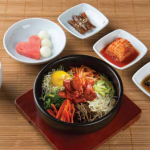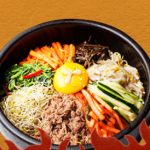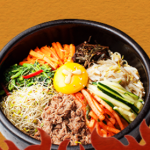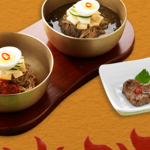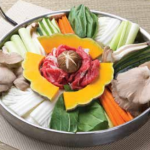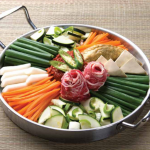Are you ready to embark on a mouthwatering journey through the vibrant and diverse world of Korean cuisine? From spicy and savory to sweet and tangy, Korean dishes captivate food enthusiasts worldwide with their distinctive flavors and alluring presentation. Join me as we delve into the popular Korean dishes that will leave you craving for more!
The Magic of Bulgogi: Grilled Marinated Beef That Melts in Your Mouth
Let’s kick off our culinary adventure with bulgogi, a tantalizing Korean BBQ dish that tantalizes your taste buds. The word “bulgogi” itself means “fire meat,” and rightly so since this marinated beef is cooked over an open fire, resulting in a smoky and irresistible flavor. Thinly sliced beef, marinated in a mixture of soy sauce, sugar, garlic, and sesame oil, is grilled to perfection. The result is a tender, juicy, and slightly sweet filling that melts in your mouth with every bite.
Kimchi: The Iconic Fermented Side Dish That Packs a Flavorful Punch
No discussion about Korean cuisine would be complete without mentioning kimchi. This traditional staple is a spicy fermented side dish made from various vegetables, but most commonly from napa cabbage. Kimchi is a true taste sensation, boasting a unique combination of spiciness, tanginess, and umami. Its complex flavors come from the fermentation process, which gives kimchi its signature pungent aroma and vibrant red color. Whether enjoyed on its own or in dishes like kimchi jjigae (a hearty stew), kimchi adds a zesty kick and a healthy dose of probiotics.
Bibimbap: A Colorful Harmony of Flavors and Textures
Get ready to indulge in a visual and culinary treat with bibimbap, a colorful rice bowl that brings together a symphony of flavors and textures. The dish features a bed of steamed rice topped with an assortment of vegetables such as carrots, spinach, mushrooms, and bean sprouts, all beautifully arranged to create an artistically appealing presentation. To elevate the taste, bibimbap is often served with a dollop of gochujang, a spicy red pepper paste, and a perfectly cooked sunny-side-up egg. Mix it all together, and you have a delightful combination of crispy, crunchy, chewy, and creamy textures in every bite.
Samgyeopsal: Grilled Pork Belly That’s a Sizzle on the Taste Buds
Prepare your taste buds for a sizzling experience with samgyeopsal, a beloved Korean dish featuring deliciously fatty slices of grilled pork belly. Similar to bulgogi, samgyeopsal is often enjoyed in a Korean BBQ setting, where you grill the meat yourself at the table. The succulent pork belly sizzles away, releasing its savory juices and delighting your senses with its rich aroma. Wrap the grilled meat in fresh lettuce leaves, adding garlic, ssamjang (a spicy dipping sauce), and other condiments to create a mouthwatering combination of flavors.
Bingsu: The Perfect Cool and Creamy Treat for Warm Days
Time to satisfy your sweet tooth with bingsu, a delightful shaved ice dessert that offers a refreshing respite on hot summer days. This popular Korean treat traditionally consists of finely shaved ice topped with a myriad of toppings, such as sweetened red beans, fruit, condensed milk, and rice cakes. The result is a bowl of finely textured ice flakes that melt in your mouth, accompanied by a burst of flavors and textures. Indulge in unique varieties like injeolmi (rice cake) bingsu or patbingsu (red bean bingsu) for an extra dose of heavenly sweetness.
Conclusion
Korean cuisine is a treasure trove of delectable dishes that will transport your taste buds to new heights. Whether you’re a spice lover, a fan of rich flavors, or simply in pursuit of a delightful culinary adventure, Korean dishes offer something for everyone. From the mouthwatering bulgogi to the addictive kimchi, bibimbap, samgyeopsal, and bingsu, these iconic dishes showcase the soul of Korean culture through their unique flavors, textures, and presentation.
FAQ
- Is Korean food always spicy?
-
While Korean cuisine is often associated with spiciness due to dishes like kimchi and gochujang, not all Korean dishes are spicy. Many dishes offer a range of flavors, including mild and non-spicy options.
-
Can vegetarians enjoy Korean food?
-
Yes, Korean cuisine offers a variety of vegetarian options. Dishes like Bibimbap can be customized without meat, and there are numerous vegetable-based side dishes and stews available.
-
Are Korean dishes healthy?
-
Korean cuisine is generally considered healthy due to its emphasis on fresh vegetables, lean meats, and fermented foods. However, some dishes may contain high sodium or sugar content, so it’s important to choose options wisely.
-
What is the etiquette for Korean BBQ?
-
In Korean BBQ, it’s customary to grill the meat yourself at the table. It’s essential to respect the barbecue etiquette by not leaving the meat on the grill for too long and not flipping it excessively.
-
Can I find Korean dishes outside of Korea?
- Yes, Korean cuisine has gained popularity worldwide, and you can find Korean restaurants in many major cities. Additionally, some Korean dishes have even been adapted into global fusion cuisine menus.
So there you have it – a brief introduction to the popular Korean dishes that will undoubtedly leave you salivating. If you’re eager to tantalize your taste buds with bold and exciting flavors, exploring Korean cuisine is undoubtedly a journey worth embarking upon. Get ready to immerse yourself in a diverse and delightful culinary experience that Korean food lovers swear by!

